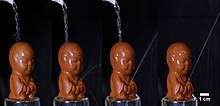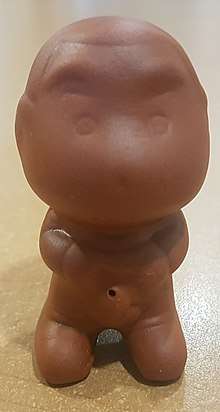Tea pet
A tea pet (Chinese: 茶宠), also known as a tea lover's pet, is a small clay figure which is kept by some tea drinkers for good luck.[1] They are usually made of "zisha" or Yixing clay, from the region near Yixing in Jiangsu province, China. Just like Yixing teapots made of the same clay, tea pets are unglazed, so that they are mostly monochromatic with a rough surface.[2] Tea lovers in China raise a tea pet by placing it on the tea tray during tea time and pouring out the tea over it. One of the most popular models for the tea pet is the "pee-pee boy" which when first soaked in cold water and then showered with hot water will squirt out the water it previously absorbed. Tea pets are also molded into zodiac animals or Chinese mythical creatures such as dragons, Pixiu, Qilin, etc., to symbolize good luck, fortune and happiness, as well as historical or mythical characters such as Guanyin, Maitreya and Zhuge Liang.
.jpg)
History

The birthplace of tea pets, Yixing, was first famous as the birthplace of "Yixing clay" in Song dynasty (960 – 1279).[4] With the popularity of the Yixing clay teapot, Yixing became a production center for teaware since then. Teapot artisans started to mold Yixing clay into various mythical creatures or animals as mascots for tea lovers. However, probably because the ancient Chinese scholars believe in a saying that "excessive attention to trivia saps the will", there is very limited literature on the development of tea pets in Chinese history. Nowadays, even with the development of the technology—it is not hard to find alternatives to Yixing clay as the material to make tea pets—the production is still concentrated in Yixing region.
Types
A tea pet is handmade using Zisha (Yixing clay) and unglazed, so it is usually in the natural color of Yixing clay. There are three kinds of Yixing clay: purple, red, and green clay. A tea pet can be made of either of one of these Yixing clays, or a mixture of two to produce different colors.
- Purple clay is the principal clay, which turns red-brown or dark-brown after firing. The artisan often adds iron clay to achieve a better color effect.
- Red clay, also known as "Stock Yellow", has a much higher contraction percentage than purple clay, and shows a vermillion color after firing. Because of its high contraction percentage, red clay is more suitable for making small-sized objects like tea pets and teapots.
- Green clay has a color similar to duck egg shell, and appears off-white after firing. It is rarer than purple clay, and more expensive on the market.
Maintenance
The way that tea lovers raise a tea pet is quite similar to the way that they maintain a Yixing clay teapot. They often pour leftover tea or leaf-rinsing water over their tea pets, and use a tea brush to wipe the surface of the tea pet to help it absorb the tea evenly. Tea pets should be only rinsed with water, without using soap or any dish-washing liquid, to ensure a progressive increase in the color of the tea. After prolonged maintenance, over months or years, the tea pet will absorb the tea, and its appearance will become glossier.

Pee-pee boy
Pee-pee boy is the most representative and popular figure among tea pets. It is about 3 inch tall with a red-brown color. Its main feature is the ability to squirt water when hot water is poured onto it. To do this, a tea lover immerses it in cold water until it is filled up and shakes it to make sure it is filled at least 50 percent with water; after that, hot water poured over the pee-pee boy will make it "pee" if the water is hot enough. The hotter the water, the further it pees. The principle behind the pee-pee boy is thermal expansion of air. It is designed to be hollow with only one tiny opening, so that water can flow into pee-pee boy at a slow pace and will not drip out until sufficient hot water is poured on its head. When hot water is poured over its head, the air in the pee-pee boy expands, resulting in the water being squeezed out through the tiny opening. Experimental and simulation results based on thermodynamics and fluid mechanics principles have verified the capability of such device to measure temperature.[3] With this feature, the pee-pee boy soon became the most popular figure in tea pets. And recently, more and more artisans also utilize this technology on other tea pets, such as water-breathing dragons or a water-spraying longevity tortoises, to provide more choices for tea lovers.
In popular culture
Tea Pets (simplified Chinese: 阿唐奇遇) is a 2017 Chinese 3D computer animated film about the adventures of a group of tea pet clay figurines.
References
- Hendren, Jay (2012). "Gongfu Cha: A New American Luxury". Colorado Journal of Asian Studies. 1 (1): 59.
- Pan, Chunfang (2004). Yixing Pottery: The World of Chinese Tea Culture. San Francisco: Long River Press. P.41-49
- Lee, Vincent; Attinger, Daniel (2016-07-19). "Thermodynamics and historical relevance of a jetting thermometer made of Chinese zisha ceramic". Scientific Reports. 6: 28609. doi:10.1038/srep28609. ISSN 2045-2322. PMC 4949419. PMID 27431925.
- Lo, Kuei-hsiang (1986). The stonewares of Yixing: From the Ming period to the present day. London: Sotheby's Publications.